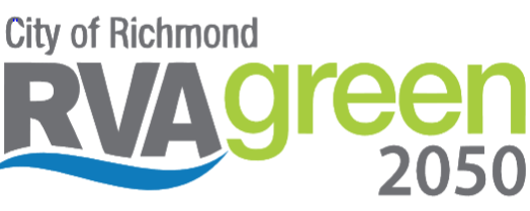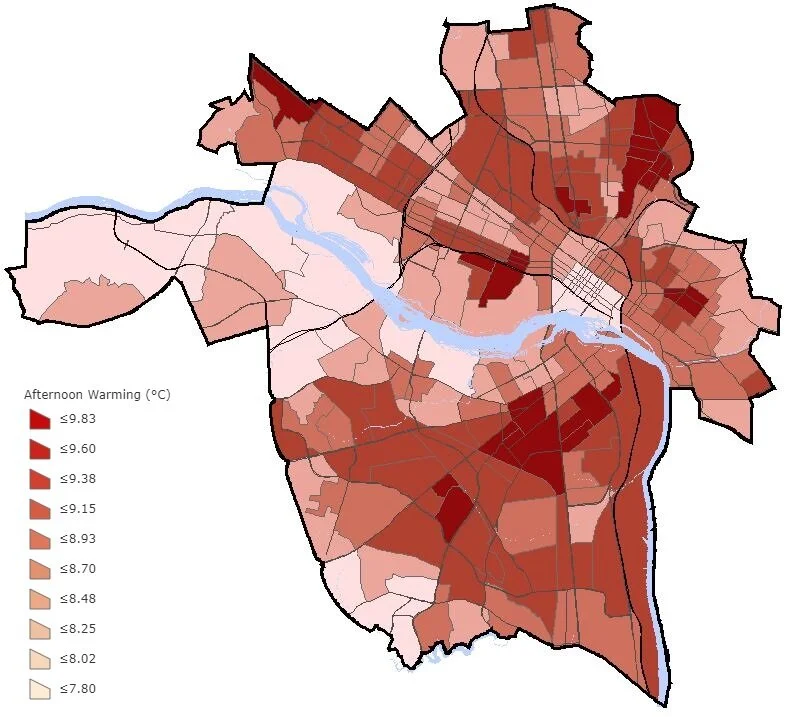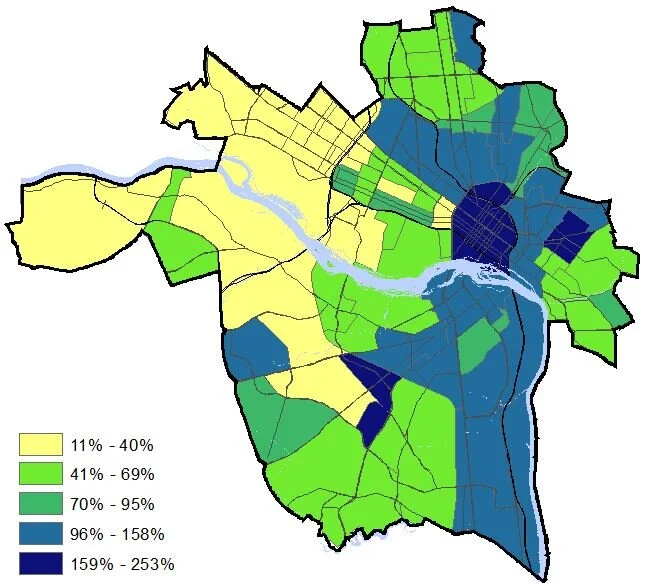Health & Well-Being
What we heard: Residents are concerned with water and air quality, violence, food access, and the impact these issues have on mental and physical health. They want more facilities and services to support better health including green spaces, bike and pedestrian infrastructure, and grocery stores.
What does this look like in Richmond? Many of Richmond’s neighborhoods face multiple inequities related to health, safety, and climate change. For example, some communities with higher rates of chronic illnesses such as asthma are also in areas that get hotter than others during heat waves (urban heat islands). Asthma can increase a person’s risk of illness during an extreme heat event, and climate change is making these events happen more frequently. Climate change is also accelerating existing social instability due to factors such as increased crime and reduced food access.
Urban Heat Islands
Source: RVAgreen 2050 Climate Equity Index, Jeremy Hoffman, Science Museum of Virginia
Adults with Asthma
Source: RVAgreen 2050 Climate Equity Index, 2016 American Community Survey
Average Annual Crime Rate Over 5 Years (Per 100 People)
Source: RVAgreen 2050 Climate Equity Index, Richmond Police Department
Low Food Access
Population Beyond 1 Mile From a Supermarket; Source: RVAgreen 2050 Climate Equity Index, USDA
Actions we’re taking:
Conducting technical modeling to demonstrate how we can reach net zero greenhouse gas emissions by 2050 with strategies that also reduce costs associated with health issues caused by carbon pollution.
Identifying neighborhoods in Richmond at a higher risk of physical and mental harm due to climate change using the Climate Equity Index.
Collaborating with the Science Museum of Virginia and other community partners on a citizen-science project to conduct neighborhood level air-quality assessments that will help inform neighborhood-specific solutions and improve the well-being of the broader community.
 RVAgreen 2050 will build on the foundation set by Richmond 300, the city’s master planning process that engaged thousands of Richmonders in identifying objectives such as these supporting physical and mental health:
RVAgreen 2050 will build on the foundation set by Richmond 300, the city’s master planning process that engaged thousands of Richmonders in identifying objectives such as these supporting physical and mental health:8.2: Increase the miles of greenways in an interconnected, regional network
15.1: Reduce air pollution related to transport
17.3: Expand access to the local healthy food system, prioritizing residents in low-income areas
17.4: Increase the percentage of Richmonders within a 10-minute walk of quality open space to 100%, prioritizing low-income areas with a high heat vulnerability index rating, with a long-term goal of having all Richmonders within a 5-minute walk of a quality open space
What you can do:
See how much hotter your hometown is than when you were born
Shop at Farmer’s Markets - you’ll support local farmers, eat seasonal which is healthier for you and the environment
Drink clean, great tasting city tap water to cut down on plastic waste and save money
Support community gardens by getting involved with Richmond Grows Gardens
Keep our air clean by limiting idling when your vehicle is stopped for an extended period of time
Check out the RVAgreen 2050 Virtual Resilience Hub resources under ‘Health & Well-being’ and ‘Environment’





